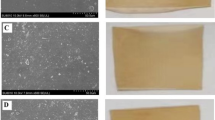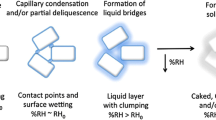Abstract
Thermodynamic properties and glass transition temperature (Tg) of heat pump dried scallop adductors with (SA-C) and without (SA) sodium alginate coating pretreatment were investigated. Single sodium alginate film (SF) was also performed for comparison. The isotherms for SA, SA-C and SF followed type II characteristics. Water adsorption capacity of SA was decreased with coating pretreatment. The net isosteric heat of adsorption (qst) and differential entropy (Sd) were exponentially decreased with increasing moisture content (MC). Spreading pressure (φ) was increased with rising water activity (aw), but decreased with elevated temperature. Sodium alginate coating pretreatment decreased the qst, Sd and φ of SA. The enthalpy–entropy compensation theory can be employed for the adsorption behaviors of 3 samples. It was enthalpy-driven non-spontaneous for SA, and enthalpy-driven spontaneous for SA-C and SF, respectively. Based on the aw concept and glass transition theory, adsorption isotherm and Tg data were modeled and combined to establish state diagram. Compared with SA, the critical MC and aw were, respectively, increased 7.14% and 187.5% with coating pretreatment. Hydrocolloids coating is an innovative pretreatment in enhancing the storage stability of dried foods.





Similar content being viewed by others
References
Zhao X, Liu Y, Wang G, Tao W, Lou Y, Li N, Liu Y. Tracing the geographical origins of Yesso scallop (Patinopecten yessoensis) by using compound-specific isotope analysis: an approach for overcoming the seasonal effect. Food Control. 2019;102:38–45.
Shi Q, Tian Y, Zhu L, Zhao Y. Effects of sodium alginate-based coating pretreatment on drying characteristics and quality of heat pump dried scallop adductors. J Sci Food Agric. 2019;99(10):4781–92.
Zhang M, Chen H, Mujumdar AS, Tang J, Miao S, Wang Y. Recent developments in high-quality drying of vegetables, fruits, and aquatic products. Crit Rev Food Sci Nutr. 2017;57(6):1239–55.
Wang Y, Zhang M, Mujumdar AS. Trends in processing technologies for dried aquatic products. Drying Technol. 2011;29(4):382–94.
Sui X, Zhao Y, Zhang X, Zhang Y, Zhu L, Fang Z, et al. Hydrocolloid coating pretreatment makes explosion puffing drying applicable in protein-rich foods: a case study of scallop adductors. Drying Technol. 2020. https://doi.org/10.1080/07373937.2020.1768108.
Deng Y, Luo Y, Wang Y, Zhao Y. Effect of different drying methods on the myosin structure, amino acid composition, protein digestibility and volatile profile of squid fillets. Food Chem. 2015;171:168–76.
Tummanichanont C, Phoungchandang S, Srzednicki G. Effects of pretreatment and drying methods on drying characteristics and quality attributes of Andrographis paniculata. J Food Process Pres. 2017;41(6):e13310.
Li M, Guan Z, Wu B-C, Wu Y. Study of freeze-thawing on the process of tilapia filiets heat pump drying. Carpathian J Food Sci Technol. 2016;8(1):23–30.
Li M, Wu Y, Ge Y, Ling C. Pulse vacuum pretreatment technology and neural network optimization in drying of tilapia fillets with heat pump. J Food Process Pres. 2019;43(12):e14258.
Witrowa-Rajchert D, Wiktor A, Sledz M, Nowacka M. Selected emerging technologies to enhance the drying process: a review. Drying Technol. 2014;32(12):1386–96.
Lago-Vanzela E, Do Nascimento P, Fontes E, Mauro M, Kimura M. Edible coatings from native and modified starches retain carotenoids in pumpkin during drying. LWT-Food Sci Technol. 2013;50(2):420–5.
Garcia CC, Caetano LC, de Souza Silva K, Mauro MA. Influence of edible coating on the drying and quality of papaya (Carica papaya). Food Bioprocess Technol. 2014;7(10):2828–39.
Silva K, Garcia C, Amado L, Mauro M. Effects of edible coatings on convective drying and characteristics of the dried pineapple. Food Bioprocess Technol. 2015;8(7):1465–75.
Qiu L, Zhang M, Tang J, Adhikari B, Cao P. Innovative technologies for producing and preserving intermediate moisture foods: a review. Food Res Int. 2019;116:90–102.
Shi Q, Xue C, Zhao Y, Li Z, Wang X. Drying characteristics of horse mackerel (Trachurus japonicus) dried in a heat pump dehumidifier. J Food Eng. 2008;84(1):12–20.
Syamaladevi RM, Tang J, Villa-Rojas R, Sablani SS, Carter B, Campbell G. Influence of water activity on thermal resistance of microorganisms in low-moisture foods: a review. Compr Rev Food Sci F. 2016;15(2):353–70.
Vermeulen A, Marvig CL, Daelman J, Xhaferi R, Nielsen DS, Devlieghere F. Strategies to increase the stability of intermediate moisture foods towards Zygosaccharomyces rouxii: the effect of temperature, ethanol, pH and water activity, with or without the influence of organic acids. Food Microbiol. 2015;45(Pt A):119–25.
Rahman MS, Suresh S, Al-Habsi N. Proton relaxation in freeze-dried broccoli as measured by low-frequency nuclear magnetic resonance (LF-NMR) and its relationship with the thermal glass transition. J Therm Anal Calorim. 2020. https://doi.org/10.1007/s10973-020-09401-8.
Rahman MS. Food stability determination by macro–micro region concept in the state diagram and by defining a critical temperature. J Food Eng. 2010;99(4):402–16.
Al-Muhtaseb AH, McMinn WAM, Magee TRA. Moisture sorption isotherm characteristics of food products: a review. Food Bioprod Process. 2002;80(2):118–28.
Bonilla E, Azuara E, Beristain CI, Vernon-Carter EJ. Predicting suitable storage conditions for spray-dried microcapsules formed with different biopolymer matrices. Food Hydrocolloid. 2010;24(6–7):633–40.
Roos YH. Glass transition temperature and its relevance in food processing. Annu Rev Food Sci Technol. 2010;1:469–96.
Shi Q, Lin W, Zhao Y, Zhang P. Thermal characteristics and state diagram of Penaeus vannamei meat with and without maltodextrin addition. Thermochim Acta. 2015;616:92–9.
Li R, Lin D, Roos YH, Miao S. Glass transition, structural relaxation and stability of spray-dried amorphous food solids: a review. Drying Technol. 2018;37(3):287–300.
Talik P, Piwowarczyk J, Muszyńska B, Hubicka U. DSC study of hydration and water-holding behaviour of cultured in vitro mycelium and naturally grown fruiting bodies of freeze-dried Boletus badius, Agaricus bisporus and Cantharellus cibarius. J Therm Anal Calorim. 2020. https://doi.org/10.1007/s10973-020-09654-3.
Schiraldi A, Fessas D. Calorimetry and thermal analysis in food science. J Therm Anal Calorim. 2019;138(4):2721–32.
Shi Q, Lin W, Zhao Y, Zhang P, Wang R. Moisture adsorption isotherms and thermodynamic properties of Penaeus vannamei meat with and without maltodextrin addition. J Aquat Food Prod T. 2016;25(8):1348–67.
Telis VRN, Gabas AL, Menegalli FC, Telis-Romero J. Water sorption thermodynamic properties applied to persimmon skin and pulp. Thermochim Acta. 2000;343(1–2):49–56.
Rhim JW, Lee JH. Thermodynamic analysis of water vapor sorption isotherms and mechanical properties of selected paper-based food packaging materials. J Food Sci. 2009;74(9):E502–11.
Polatoğlu B, Beşe AV, Kaya M, Aktaş N. Moisture adsorption isotherms and thermodynamics properties of sucuk (Turkish dry-fermented sausage). Food and Bioprod Process. 2011;89(4):449–56.
Aksil T, Abbas M, Trari M, Benamara S. Water adsorption on lyophilized Arbutus unedo L. fruit powder: determination of thermodynamic parameters. Microchem J. 2019;145:35–41.
Alpizar-Reyes E, Carrillo-Navas H, Romero-Romero R, Varela-Guerrero V, Alvarez-Ramírez J, Pérez-Alonso C. Thermodynamic sorption properties and glass transition temperature of tamarind seed mucilage (Tamarindus indica L.). Food Bioprod Process. 2017;101:166–76.
Krug RR, Hunter WG, Grieger RA. Enthalpy–Entropy compensation. 1. Some fundamental statistical problems associated with the analysis of van’t Hoff and Arrhenius data. J Phys Chem. 1976;80(21):2335–41.
Krug RR, Hunter WG, Grieger RA. Enthalpy–entropy compensation. 2. Separation of chemical from statistical effect. J Phys Chem. 1976;80(21):2341–51.
Velazquez-Gutierrez SK, Figueira AC, Rodriguez-Huezo ME, Roman-Guerrero A, Carrillo-Navas H, Perez-Alonso C. Sorption isotherms, thermodynamic properties and glass transition temperature of mucilage extracted from chia seeds (Salvia hispanica L.). Carbohydr Polym. 2015;121:411–9.
Moraes K, Pinto LAA. Desorption isotherms and thermodynamics properties of anchovy in natura and enzymatic modified paste. J Food Eng. 2012;110(4):507–13.
Delgaado AE, Sun D-W. Desorption isotherms and glass transition temperature for chicken meat. J Food Eng. 2002;55:1–8.
Tian Y, Zhao Y, Shi Q. Appropriate coating pretreatment enhancing osmotic dehydration efficiency of scallop adductors. Trans ASAE. 2016;32(17):266–73.
Monte ML, Moreno ML, Senna J, Arrieche LS, Pinto LAA. Moisture sorption isotherms of chitosan-glycerol films: thermodynamic properties and microstructure. Food Biosci. 2018;22:170–7.
Martinez-Monteagudo SI, Salais-Fierro F. Moisture sorption isotherms and thermodynamic properties of mexican mennonite-style cheese. J Food Sci Technol. 2014;51(10):2393–403.
Quirijns EJ, van Boxtel AJB, van Loon WKP, van Straten G. Sorption isotherms, GAB parameters and isosteric heat of sorption. J Sci Food Agric. 2005;85(11):1805–14.
Viganó J, Azuara E, Telis VRN, Beristain CI, Jiménez M, Telis-Romeroa J. Role of enthalpy and entropy in moisture sorption behavior of pineapple pulp powder produced by different drying methods. Thermochim Acta. 2012;528(20):63–71.
Lago CC, Noreña CPZ. Thermodynamic analysis of sorption isotherms of dehydrated yacon (Smallanthus sonchifolius) bagasse. Food Biosci. 2015;12:26–33.
Xiao Q, Tong Q. Thermodynamic properties of moisture sorption in pullulan–sodium alginate based edible films. Food Res Int. 2013;54(2):1605–12.
Spada JC, Noreña CPZ, Marczak LDF, Tessaro IC. Water adsorption isotherms of microcapsules with hydrolyzed pinhão (Araucaria angustifolia seeds) starch as wall material. J Food Eng. 2013;114(1):64–9.
Fabra MJ, Talens P, Chiralt A. Water sorption isotherms and phase transitions of sodium caseinate–lipid films as affected by lipid interactions. Food Hydrocolloid. 2010;24(4):384–91.
Sablani SS, Syamaladevi RM, Swanson BG. A review of methods, data and applications of state diagrams of food systems. Food Eng Rev. 2010;2(3):168–203.
Roos YH. Water activity and physical state effects on amorphous food stability. J Food Process Preser. 1993;16(6):433–47.
Roos YH. Characterization of food polymers using state diagrams. J Food Eng. 1995;24(3):339–60.
Slade L, Levine H. Beyond water activity: recent advances based on an alternative approach to the assessment of food quality and safety. Crit Rev Food Sci Nutr. 1991;30(2–3):115–360.
Acknowledgements
The authors would like to acknowledge the financial support of the National Natural Science Foundation of China (No. 31171708; No. 31571915).
Author information
Authors and Affiliations
Corresponding author
Ethics declarations
Conflict of interest
The authors declare no potential conflict of interest.
Additional information
Publisher's Note
Springer Nature remains neutral with regard to jurisdictional claims in published maps and institutional affiliations.
Rights and permissions
About this article
Cite this article
Tian, Y., Zhao, Y., Zhang, X. et al. Sodium alginate coating pretreatment improved storage stability of heat pump dried scallop adductors: from thermal and thermodynamic points of view. J Therm Anal Calorim 146, 1335–1345 (2021). https://doi.org/10.1007/s10973-020-10087-1
Received:
Accepted:
Published:
Issue Date:
DOI: https://doi.org/10.1007/s10973-020-10087-1




